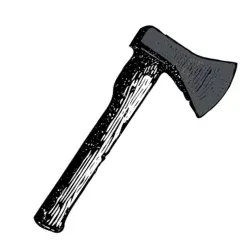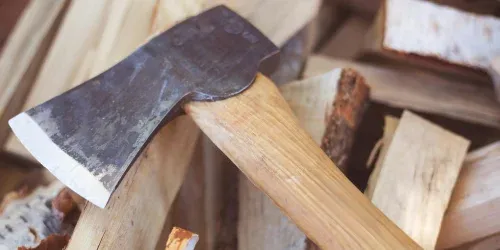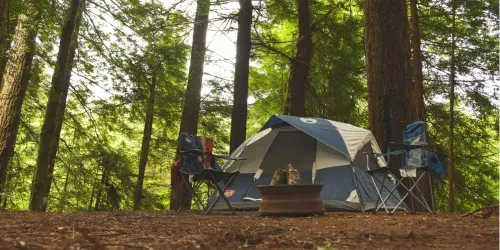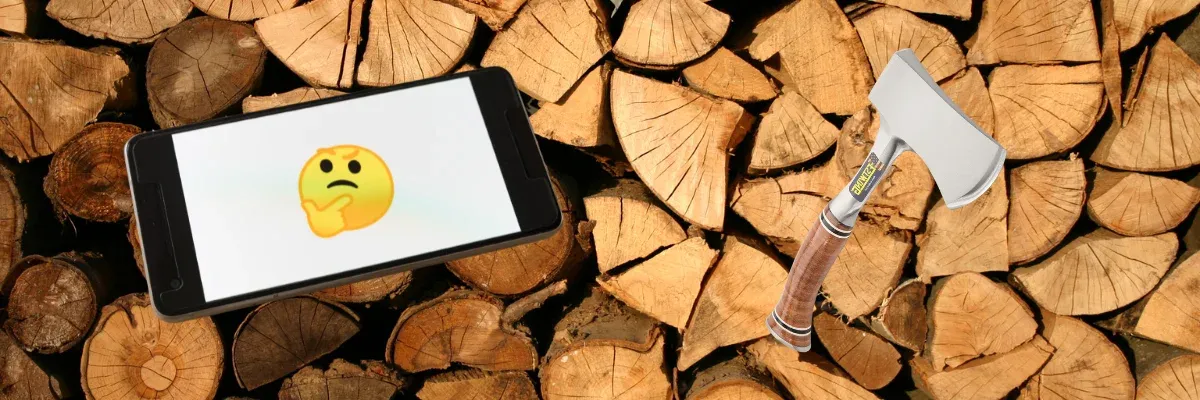When you're gearing up for a camping trip, choosing the right tools can make all the difference. Among these, the axe is a pivotal piece of equipment, especially if you plan to split firewood or engage in any bushcraft. But with a plethora of axes on the market, how do you determine the best size for your camping needs?
Key Takeaways:
- Versatility and Portability: A small forest axe or a bushcraft hatchet is often ideal for camping due to its lightweight and multifunctional nature.
- Task Suitability: The size of the axe should match the specific tasks you anticipate, such as splitting kindling or chopping larger pieces of wood.
- Material and Build: Look for axes with durable materials like a hickory handle and a sharp steel blade to ensure longevity and efficiency.

Understanding the Basics: What's in an Axe?
An axe primarily consists of two parts: the handle and the axe head. The handle material and length influence the swing power and control, while the head shape and weight impact the axe's efficiency in cutting or splitting. For the best camping axe, it's crucial to find a balance that offers both portability and functionality.
Handle Material: More Than Just Wood
While traditional axes often feature a hickory handle known for its durability and shock absorption, modern camping axes might sport composite handles. These are not only lighter but also resistant to surface rust and wear, making them well-suited for the damp environments often encountered on camping trips.
Head Shape and Size: The Cutting Edge
The shape of the axe head plays a crucial role in determining its suitability for specific tasks. A sharper, thinner head is typically better for chopping firewood, as it can easily cut through the wood fibers. On the other hand, a broader and heavier head is ideal for splitting firewood, as it drives through the wood, forcing it apart.
Choosing the Right Size for Camping
The size of the axe you choose for camping should directly correlate with the tasks you intend to perform. Whether it's splitting kindling, chopping wood, or even more detailed tasks like carving, the size and type of axe can greatly influence your ability to perform these tasks competently.
The Art of Splitting: Choosing the Right Axe for Firewood
When you're out in the wild, the crackle of a good campfire is like music to the ears. But before you can enjoy that, you need the right tool for splitting firewood. Most axes designed for camping are crafted to handle this task, but the choice of axe can make a significant difference. A small forest axe, for instance, offers a sharp edge and a handle length that provides enough leverage for chopping through medium-sized logs efficiently. Its compact size also makes it easy to carry on any camping trip, often coming with a handy belt loop or plastic sheath for easy transport.

On the other hand, if you're planning to split larger pieces of wood, a long splitter axe might be your best bet. These axes typically feature a longer handle and a heavier head, giving you the extra power needed to split big pieces of firewood with fewer swings. This type of axe is less about finesse and more about brute force, making it ideal for preparing a larger fire that will burn wood for extended periods. Remember, the key to effective wood splitting is not just the size of the axe, but also how well it suits the specific tasks you expect to face during your camping adventures.
Small Forest Axe: The Jack of All Trades
A small forest axe, typically with a handle length of about 19 to 20 inches, offers great versatility. It's long enough to chop small to medium-sized logs yet short enough to be wielded comfortably with one hand for smaller, more precise tasks. This type of axe is a great value choice for those who need a multi-purpose tool.
Bushcraft Hatchet: Compact Power
For those who prioritize portability and are primarily dealing with smaller pieces of wood or kindling, a bushcraft hatchet is ideal. These hatchets usually have a shorter handle and a well-balanced head, perfect for carrying on a belt loop or in a backpack with a plastic sheath for protection.
Specialized Axes for Specific Needs
Depending on your skill level and the nature of your camping trips, you might find that a specialized axe better suits your needs.
Fine-Tuning Your Technique: Axes for Detailed Tasks
For those who treasure precision and efficiency in their camping tools, focusing on axes and hatchets that are well-suited for detailed tasks is crucial. Smaller hatchets, such as the bushcraft hatchet, are perfect for more intricate work like carving and kindling. These tools are generally lighter and have a shorter handle, allowing for better control and ease of use with one hand. The sharp, well-balanced head of a bushcraft hatchet makes it excellent for tasks that require a delicate touch, yet it's still robust enough to handle tougher jobs like chopping small limbs off trees.

Mid-Sized Hudson Bay: Versatile and Efficient
The Hudson Bay axe, with its mid-sized handle and larger head, offers a good balance between chopping and splitting capabilities. This type of axe is suited for those who expect to deal with a variety of wood sizes but prefer not to carry multiple axes.
Long Splitter: For the Heavy Duty Tasks
If your camping trip involves splitting large pieces of firewood, a long splitter axe, typically with a handle over 27 inches, can be the best choice. The longer handle provides more swing power, allowing you to split larger pieces of wood more efficiently.
Maintenance and Care: Keeping Your Axe in Top Shape
To ensure your axe remains effective and safe to use, regular maintenance is key. This includes sharpening the blade, treating the handle, and protecting the axe from the elements.
Sharpening: Keeping the Edge
A sharp edge is crucial for both safety and efficiency. Use a file or whetstone to maintain the edge, and always follow the original angle of the blade. Regular sharpening, depending on use, can significantly extend the life of your axe.
Handle Care: Preventing Wear and Tear
Treat wooden handles with linseed oil to prevent drying and cracking. For composite handles, regular inspections for cracks or splits are essential, as these materials can degrade over time, especially with exposure to extreme temperatures.

Summary
Choosing the right size axe for camping involves considering the intended use, handle material, and overall length. A small forest axe or a bushcraft hatchet often provides the best balance of functionality and portability for general camping needs. For more specialized tasks, larger or more specific axe types like the Hudson Bay or long splitter may be appropriate. Regular maintenance, including sharpening the blade and caring for the handle, will ensure your axe remains a reliable companion on many camping adventures.

FAQs
How do I choose between a hatchet and a small forest axe for camping?
Consider the tasks you'll be performing most. If you need something lightweight and for smaller tasks like making kindling, go for a hatchet. If you need something for a variety of tasks including chopping small logs, a small forest axe is better.
Can I use a regular hardware store axe for camping?
While you can, it's better to choose an axe specifically designed for camping, as they are typically built to be more durable and suited for the varied tasks associated with camping.
How often should I sharpen my camping axe?
Sharpen your axe as needed, which generally means after every trip or after extensive use during a trip, especially if you notice it becoming dull. Regular maintenance ensures it's always ready for the next adventure.









